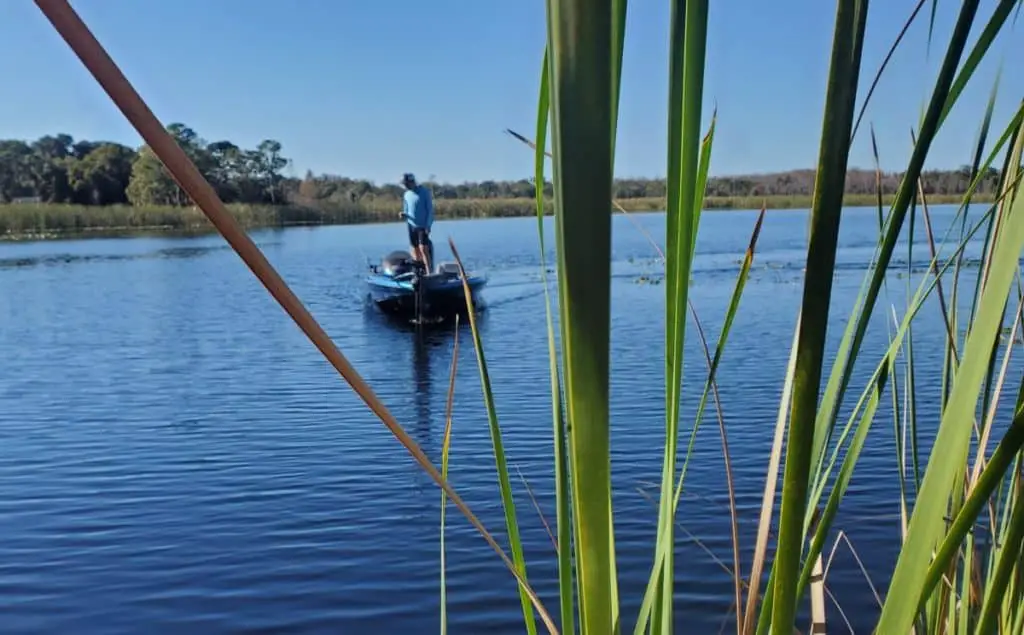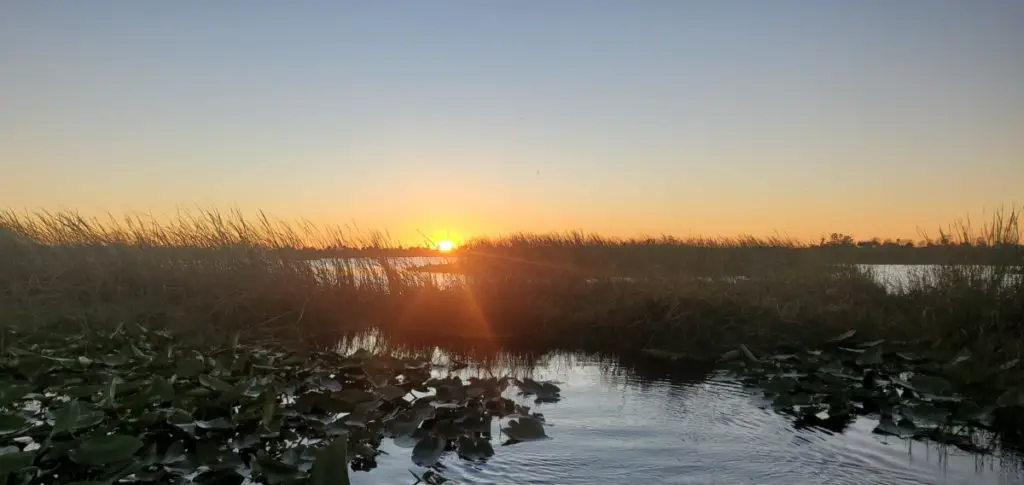
Understanding the movement of bass relative to the corresponding water temperature is key to finding them during different times of the year. The dog days of summer mean warmer water which directly affects the movement of cold-blooded bass.
When it’s hot, bass go where they can find cooler water and more oxygen. In shallow water habitats, they look for anything that provides shade, including docks, pads, reed clumps, overhanging trees, and matted vegetation. In deep water environments, bass migrate to structures like main lake points, river channel bends, and offshore grass in search of stable, oxygen-rich water.
Read on for excellent information that will help you understand where bass go during the summer. We’ll also discuss the best ways to catch bass in the hot summer months.
12 Places that Bass Go When It’s Hot (and How to Fish Them)
- Current
Bass are strongly attracted to current in certain conditions. When the weather is hot, bass seek current for two important reasons. First, they love it because the water movement associated with the current provides fish with water that has a higher content of oxygen. Second, moving water provides a source of food like baitfish and bugs that get pushed through the water column to bass waiting for a meal.
Current can be man-made, wind produced, or naturally occurring. Fishing current can be very productive. Some of the best baits to fish in current are soft plastics and jigs for a slower presentation. These weighted baits are perfect for slowing down and methodically picking apart ambush points. Moving baits like crankbaits and spinnerbaits can be very effective as well.
- Overhanging Trees and Bushes for Summertime Bass
Bass looking for a reprieve from the sun’s rays look for anything that provides them with shade. For shallow-water bass, overhanging trees and bushes provide a perfect spot to rest in the shade.
In addition to the shade, bass use the same bushes and trees to lie in wait for easy meals. Bugs, toads, lizards, small snakes, and many other creatures end up in the water after falling from branches or the shore. I’ve observed bass in these settings hundreds of times. They stare, facing the bank waiting for their next free meal. Take advantage of this perfect opportunity to catch shallow summer bass.
The formula is simple: Shade = Bass.
However, finding bass is one thing, while catching them is another.
There are a few fundamental principles to keep in mind when fishing for bass tucked away in tough-to-reach places.
First, you will have to become proficient at skipping baits up under objects (trees, bushes) using a combination of sidearm and underhanded casts.
Second, you’ll need to use a weedless/snagless presentation to have the best chance of reaching fish under overhanging brush without getting stuck. Some of the best baits to use when it’s hot include an unweighted stick worm, jig, toad, fluke, or a frog, all great candidates for skipping under cover. All those baits are fished with a hook buried into the bait, which should drastically cut down on your chances of getting stuck.
Finally, If the trees or bushes are touching the top of the water, meaning that you can’t skip under them, you’ll probably need to opt for a punch bait to penetrate the cover instead.
- Docks
Docks are one of my favorite spots to fish for bass when it’s hot out and the sun is bright. Bass rely on docks for ample and consistent shade year-round, especially when the water heats up.
When fishing a dock, be sure to approach the dock systematically so that you fish from the outside in.
Start with the outside edges of the dock first. The side of the dock with the most shade will likely produce the best results. Slower moving baits like drop shots, Texas rig worms, and shaky heads are great baits to use for outside dock edges for lethargic summertime bass.
Fish may be more aggressive and active if it’s morning, evening, or overcast. Chatterbaits, spinnerbaits, and squarebills are all great moving baits made to deflect off of solid objects like dock pilings.
After you have fished the outside edges of the dock, work the inside with baits and lures that you can skip up under the dock as far as possible. Two of my favorite baits to skip are wacky rigs or Neko rigs on a spinning reel. I have probably had most of my success bass fishing on this setup, but it takes PRACTICE to skip them well. However, it’s a very effective presentation for dock-related fish once perfected.
- Lily Pads

Lily pads are one form of cover that always seem to hold fish. Summertime fishing for bass would be incomplete without mentioning pad fishing as part of a game plan.
Pads provide shade and are used extensively for bass as a summertime retreat. Here are some of my favorite baits and lures for fishing for pads in lily pads
- Frogs. Frogs are an excellent topwater option for fishing in pads because they are virtually weedless. Fish them a little faster early in the morning or at dusk. Slow down as mid-day approaches. Frogs are an excellent option for thick or sparse pads. The thicker the pads, the heavier the frog. If pads are very thick, put a few BBs in the body of the frog to weigh it down so it makes more of an impression on the cover for bass to see. Check out some great frog fishing options on Amazon here.
- Toads. Toads are great for pads that aren’t too thick. Most people fish toads unweighted, so they don’t “mash” down on vegetation. They slide and flutter in the water, so they’re best used when they can make contact with the water in sparse pads. Toad fishing is one of my favorite ways to catch bass.
- Swim Jigs. Swim jigs are highly effective for fishing in moderately dense pads. They’re best fished fairly rapidly below the water’s surface to elicit a reaction bite.
- Punch Baits. When pads are overgrown or very thick, they become tougher to fish. Therefore, you’ll need to opt for a punch or flipping bait for thick pads. Use a weight that’s just heavy enough to penetrate the initial layer of pads but not so heavy that it causes too much commotion when it lands. You’ll also want your bait to fall as slowly as possible after it hits the water to give bass time to see it before it hits bottom. All punch baits are not created equal. I like the Berkley Pit Boss. You can find them here on Amazon.
- Large Rocks or Boulders
Many bodies of water are covered in rocks and boulders. Larger rocks can cast a nice shadow for bass to rest in. Fishfinders can be a tremendous asset in finding underwater cover like big boulders where bass hang out.
Look for shadows on your sonar. The bigger the shadow, the bigger the object. Find small white dots in the shadows, and you’ve likely found waiting bass.
Crankbaits are great for working boulder shadows. If a moving bait doesn’t tempt bass, change up to something slow like a soft plastic worm, jig, or drop shot rig.
- Brushpiles
Bass look for cover underwater in the same ways they look for cover that you can see above water. Underwater man-made brush piles are there for a reason: they attract fish. Hot summer bass fishing is prime time for brush pile fishing.
Finding brush piles is an excellent way to locate bass during times of the year when they seek refuge from harsh weather conditions. Brush piles provide shade and protection, much like a bush you can see above water.
Crankbaits work well when fished at a depth where they barely tick the tops of the brush piles. Try a drop shot (Amazon) rigged with a soft plastic or a football jig for slower tactics. Both presentations work very well for bass holding tight to brush piles.
- Shallow
Much of the conventional thought for summertime fishing is to head to deeper water because that’s where most bass reside. Of course, that is sage advice, but shallow water should not be overlooked.
Shallow water can be a bass magnet during warm-water months, especially during certain times of the day or during certain conditions. For example, early morning or dusk hours are perfect for spending time up shallow looking for bass.
Bass follow the bait to the shallows to feed, especially during lower light settings. You should also consider fishing shallow, open water NEAR good cover when overcast conditions are present.
Bass will come out of hiding to feed when clouds block the bright sun. When this happens, be ready to throw moving baits like walking baits and rattle traps to catch the attention of bass suspended and away from typical summer cover.
- Deep Water Structure
It’s no secret that bass head to deeper water when water temps rise. Bass head deep offshore to look for stabilized conditions and oxygenated water.
Before summer is in full swing, bass use “underwater highways” as travel lanes to move from spawning flats and staging areas to deep water. Ditches, drains, old roadbeds, and creek beds are perfect for checking for bass moving from shallow to deep water. Crankbaits and jerkbaits (in clearer water) are excellent moving bait options. Jigs and Carolina rigs are productive slower baits for these settings.
Once summer hits hard and water temperatures begin to peak, look for underwater structures like points, humps, ledges, holes, and sunken islands for the best chance to find bass who have set up shop for the summer months. Fish these kinds of structures with crankbaits, a big worm, drop shot, or shaky heads for best results.
- Matted Vegetation
One of the best ways to consistently catch summertime bass is by systematically and methodically picking apart areas of matted vegetation. During the hottest summer periods, matted vegetation is one of the first places I look for bass seeking cover. They’ll often dig into the thickest stuff they can find to escape the heat.
Two of my favorite techniques for fishing matted vegetation for bass are using frogs and punching.
Frogs are awesome to fish on top of the mats to peak the interest of waiting bass submerged under thick grass, muck, or other weeds. Be sure to fish with a frog with enough bulk or added weight (BBs embedded into the body of the frog work well) to make an impression on the mat, so bass can find the bait they are hearing or sensing above. They’re fished weedless, which fits the bill for thick mats.
A second great approach for fishing for bass in matted vegetation is punching. Punching a soft plastic creature bait through mats, hyacinths, or other weeds is great for reaching summertime bass hunkered down under the gunk. I’ll often use weights as heavy as an ounce or an ounce and a half and occasionally need something as big as a two-ounce weight for heavy, thick vegetation. Be sure to choose the best line for bass fishing that can withstand the pressure of heavy vegetation fishing.
Be sure to approach mats quietly with as little commotion as possible to avoid spooking the fish. Fish mats from the outside in for the same reasons that this strategy works on docks.
- Cooler Water Ingress
Any cooler water is a draw for bass. The slightest deviation in water temperature can mean big things to bass dealing with hot water in summer.
Cool water ingress points are worth serious consideration when most of the water in a fishery is hot. Rainwater entry points, creek runoff spots, springs, and other cold-water spots warrant attention.
These spots are usually very large, so fish them with a slower presentation to avoid burning them out. Wacky rigs and senkos are two of the best bass lures for hot summer days and are perfect baits for working these kinds of spots where bass are more sedentary in the cooler water.
- Reeds
Reeds, reed clumps, and reed lines create a natural shade setting where bass can hide, waiting to attack prey. Flipping reeds with a weighted soft plastic often yields excellent results. You’ll need patience and perseverance, as it takes a persistent mentality to “pick apart” reeds. Flipping is a numbers game. The more presentations you make, the better your odds. This tactic takes time but can be highly fruitful in challenging weather.
Read How Do You Fish for Bass in Reeds for more great information and strategies.
- Bridges
Last but not least, bridges are a vast sanctuary for bass during high sun periods. As a result, many anglers spend their time on the water during the summer focusing on bridges and bridge structures exclusively and for good reason.
Carolina rigs are excellent for slowly working the shade lines of a bridge. If you find fish stacked up deep on bridges, deep-diving crankbaits are a worthwhile lure to have tied on to cover a little more water. Jerkbaits are effective for summer bass and can be used to “call up” fish from their deepwater homes near bridges. Finally, drop shots are an excellent finesse tactic for bridges when the bite is super slow and you need something that can spark the interest of lethargic, inactive bass.
Insider Extra
For more great hot-weather bass fishing information, check out 11 Helpful Tips for Summer Bass Fishing Success.
The Bass Line. Final Word.
Bass fishing on hot, sunny days can be challenging, but by following the tips above, you will be on your way to a successful day on the water. Catching bass when it’s hot outside starts with an understanding of where they like to go when the water heats up. Bass are logical and follow somewhat predictable patterns of seasonal movement.
Bass look for cooler water by seeking shallow water shade or deep structures searching for oxygen-rich water. Focus on targeting areas with these few things in common, and you’ll increase your chances for a hot bite in hot summer weather.
Time to wet a line and get your fish on!




